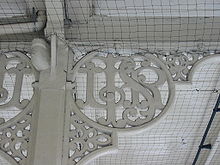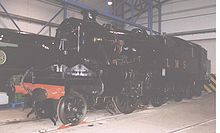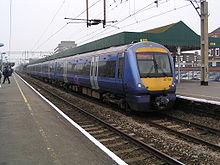- London, Tilbury and Southend Railway
-
London-Tilbury-Southend Line
Class 357 unit between Barking and Upminster.Overview Type Commuter rail, Heavy rail System National Rail Status Operational Locale Greater London
East of EnglandTermini London Fenchurch Street
ShoeburynessStations 26 Operation Opened 1854 Owner Network Rail Operator(s) c2c Depot(s) East Ham and Shoeburyness Rolling stock British Rail Class 357 Technical Line length 39.5 miles (63.57 km) No. of tracks 2 Track gauge 1,435 mm (4 ft 8 1⁄2 in) Standard gauge Electrification 25 kV AC Operating speed up to 75 mph (121 km/h) The London, Tilbury and Southend Railway is an English railway line linking Fenchurch Street railway station in the City of London with northeast London and the entire length of the northern Thames Gateway area of southern Essex. It is currently known as the Essex Thameside Route by Network Rail and forms part of strategic route 6.[1] It is classified as a London and South East commuter line.[2] Train services on the line are currently operated by c2c, a train operating company that is part of the National Express Group.
The main route from Fenchurch Street to Shoeburyness via Basildon is 39.5 miles (63.57 km) and the fastest timetabled journey time from Fenchurch Street to Shoeburyness is 58 minutes[3] giving an average speed of 40.7 mph, although the route can be done in 47 minutes, giving an average speed of 50 mph.[1] A loop line serving Tilbury provides an alternative connection from London to Southend; and a branch line connecting the two via Chafford Hundred forms a third route. The line currently has a maximum speed limit of 75 mph (121 km/h), although the Class 357 Electrostar trains which run on it are capable of a maximum speed of 100 mph (160 km/h).
The line was authorised in 1852 and the first section was opened in 1854 by the London, Tilbury and Southend Railway Company, which was a joint venture between the London and Blackwall Railway and the Eastern Counties Railway. The line was extended in phases and partnerships were formed with the Midland Railway and Metropolitan District Railway to provide through services. The line was purchased by the Midland Railway in 1912 and became part of the London, Midland and Scottish Railway in 1923.
Contents
History
Initial construction
Construction of the line was authorised by Parliament on 17 June 1852.[4] The first section, constructed by Peto and Grissell, was opened between Forest Gate junction on the Eastern Counties Railway and Tilbury, via Barking and Grays on 13 April 1854.[5] Services initially ran from Fenchurch Street and Bishopsgate stations over existing lines to Stratford and Forest Gate junction. The line was extended from Tilbury to Southend in 1856.[5] In 1858 a more direct route to Fenchurch Street was constructed through Bromley, Plaistow and East Ham,[5] connecting with the London and Blackwall Extension Railway at Bow; and the service from Bishopsgate was withdrawn. Under the management of civil engineer Arthur Lewis Stride the line was extended from Southend to Shoeburyness in 1884.[5] A more direct route from Barking to Pitsea via Upminster was constructed between 1885 and 1888, completing the current main route.[5] A single line branch was constructed between Romford and Grays via Upminster during 1892 and 1893.
Route development
In 1902 the Whitechapel and Bow Railway was constructed as a joint venture with the Metropolitan District Railway, connecting the London, Tilbury and Southend Railway at Bow with the Metropolitan District at Whitechapel. The connection allowed through running of Metropolitan District trains from the tunnels under central London to provide local services to Upminster from 2 June 1902.[6] When the Metropolitan District and Whitechapel and Bow Railway lines were electrified, an additional pair of tracks were constructed between Bow and East Ham and the service was cut back to there on 30 September 1905.[6] The electrified tracks were extended to Barking and opened on 1 April 1908.[6] Delayed by World War I,[5] the electric tracks were extended to Upminster and District line services started on 12 September 1932.[6] The London Plan Working Party Report of 1949 envisaged as its Route G the LTSR electrified and diverted away from Fenchurch Street to the Bank and on through the Waterloo & City Line tunnels to Waterloo and its suburban lines.[7] Of course, the Waterloo & City tunnels would have had to be bored out to main line size for this "Crossrail" to happen. However, electrification went ahead from 1961 to 1962 [5] and direct passenger services from Bromley, Plaistow, Upton Park, East Ham, Becontree, Dagenham and Hornchurch to Fenchurch Street were withdrawn. In 1974 a station opened to serve the new town of Basildon and in 1995 a station was built at Chafford Hundred to serve the new community there and Lakeside Shopping Centre. Platforms were reestablished and opened at West Ham station in 1999 to provide interchange with the extended Jubilee line.
Ownership and management
The railway was initially jointly promoted by the Eastern Counties Railway and London and Blackwall Railway and was leased for 21 years to Peto, Brassey and Betts.[8] The Midland Railway and London, Tilbury and Southend Railway jointly constructed the Tottenham and Forest Gate Railway, which enabled through running of trains between St Pancras railway station and Tilbury Docks.[5] In 1912 the London, Tilbury and Southend Railway was purchased by the Midland Railway.[5] At grouping in 1923, the line became part of the London, Midland and Scottish Railway.[5] The London, Midland and Scottish Railway was nationalised into British Railways in 1948 and in 1949 became part of the Eastern Region. In 1986 the route was transferred to the Network SouthEast sector of British Rail. On privatisation in 1996, ownership passed to Railtrack and Prism Rail took over operations; marketing the route as LTS Rail.[5] Ownership passed to Network Rail in 2002. Prism Rail were bought out by National Express Group in 2000 and in 2002 the line was rebranded as c2c.
Rolling stock
The line was known for its use of 4-4-2 tank engines which were later displaced by 2-6-4Ts after it had been absorbed into the London, Midland and Scottish Railway (LMS) in 1923. In 1958 an accident at Dagenham East caused the loss of 10 lives.
Modernisation
During the early 1990s proposals were put forward to convert the whole line into a guided busway, however these plans were quickly dismissed when British Rail announced a complete re-signalling of the line. Over the years the LTS had been used in an almost experimental fashion and contained a whole host of different signalling systems (e.g. geographical, WESTPAC and relay interlockings). In 1995 work got underway to replace everything from signals and point machines to whole junctions.
The main contractor for the work was GEC Alsthom who provided a Mark 3 Solid State Interlocking (SSI) system with SEMA providing the IECC element at Upminster that replaced all signal boxes on the whole line. Main line running signals mostly became 4 aspect colour lights (replacing searchlight signals amongst others), all point machines were replaced with HW2000 machines and the whole line had a complete fibre optic network installed. All level crossings were renewed with full barriers to be CCTV controlled by a designated workstation at Upminster.
The main line between Fenchurch Street and Shoeburyness was also bi-directionally signalled (with 3 aspect signalling) along most parts, with the bi-directional section alternating from one track to the other between certain stations, to provide maximum flexibility for continuing operations should disruption occur.
The line was re-signalled over the Easter weekend 1996 when all the signal boxes from Fenchurch Street to Shoeburyness (via Basildon)were switched out and control was transferred to Upminster IECC. This was later followed over the 1996 August bank holiday when Upminster took control from the remaining boxes on the Tilbury Loop.
Stations
Station Local authority Fare zone Usagea Startb TPHc Connections Main route London Fenchurch Street City of London 1 15.976 1854 8 Tower Hill tube station and Tower Gateway DLR station Limehouse Tower Hamlets 2 2.480 1854 6 DLR West Ham Newham 3 1.176 1901d 8 District line, Hammersmith and City line, Jubilee line, DLR Barking Barking and Dagenham 4 3.559 1854 8 Barking to Pitsea via Rainham loop, District line, Hammersmith and City line, Gospel Oak to Barking Line Upminster Havering 6 2.617 1885 6 Upminster to Grays branch, District line, Romford to Upminster Line West Horndon Brentwood outside zones 0.349 1888 2 Laindon Basildon outside zones 1.764 1888 4 Basildon Basildon outside zones 2.538 1974 4 Pitsea Basildon outside zones 1.046 1855 4 Barking to Pitsea via Rainham loop Benfleet Castle Point outside zones 2.989 1855 6 Leigh on Sea Southend-on-Sea outside zones 1.791 1856 6 Chalkwell Southend-on-Sea outside zones 1.313 1856 6 Westcliff Southend-on-Sea outside zones 1.026 1895 6 Southend Central Southend-on-Sea outside zones 1.904 1856 6 Southend East Southend-on-Sea outside zones 1.459 1932 4 Thorpe Bay Southend-on-Sea outside zones 0.752 1884 4 Shoeburyness Southend-on-Sea outside zones 0.599 1884 4 Upminster to Grays branch Ockendon Thurrock G 0.618 1892 2 Chafford Hundred Thurrock G 2.066 1993 2 Barking to Pitsea via Rainham loop Dagenham Dock Barking and Dagenham 5 0.641 1854 2 Rainham Havering 6 1.825 1854 2 Purfleet Thurrock G 0.433 1854 2 Grays Thurrock G 2.884 1854 4 Upminster to Grays branch Tilbury Town Thurrock outside zones 0.537 1854 2 East Tilbury Thurrock outside zones 0.337 1936 2 Stanford-le-Hope Thurrock outside zones 0.939 1854 2 - ^a Millions of entries and exits during the 2007/08 financial year[9]
- ^b Year station first served by London, Tilbury and Southend Railway service (could be served earlier by another company)
- ^c Off-peak Monday-Saturday trains per hour frequency in the December 2009 timetable[3]
- ^d Service suspended in 1913 and reintroduced in 1999
Diversion to Liverpool Street
When necessary, due to engineering work or other problems, trains can be diverted at Barking over the Gospel Oak to Barking Line and then the Great Eastern Main Line to call at Stratford and Liverpool Street. Trains diverted at Barking, having passed Stratford, can also rejoin the London, Tilbury and Southend line before Limehouse (avoiding West Ham) and continue to Fenchurch Street. This diversionary route is less often used and consists of a short section of single track at Bow. From May 1985[4] to May 2007, the weekday evening service after 22:30 operated from Liverpool Street. As of May 2010, most through services now start and terminate at Fenchurch Street, with a limited number of early morning and late night services operating to and from Liverpool Street.[3]
Line guide
London, Tilbury & Southend Line Legend

Shoeburyness 

Thorpe Bay 

Southend East 

Southend Central 

Westcliff 

Chalkwell 

Leigh-on-Sea 

Benfleet 



Pitsea 

Basildon 

Laindon 

Stanford-le-Hope 

East Tilbury 





Tilbury Riverside 



Tilbury Town 



West Horndon 



Grays 







Chafford Hundred 



Ockendon 







Upminster 




Purfleet 



Rainham 



Dagenham Dock 





Barking 


West Ham 


Limehouse 


London Fenchurch Street Proposed developments
2007 proposals
The Greater Anglia RUS, published in December 2007, outlined a number of developments intended for the Thameside Route. In the medium term, 2009–14, this includes minor infrastructure works and additional rolling stock to allow all main line peak-service trains to be extended to 12-car formation. Also included is the proposal for the extension of platforms on the Tilbury loop and Ockendon branch to handle 12 cars, to allow all main line peak-service trains to be extended to 8 or 12-car formation. In the longer term intentions are to continue the lengthening of peak trains to 12-car formation.[10] A new railway station is proposed at Beam Reach, between Rainham and Purfleet.[11]
London Gateway (port) link
A link to the London Gateway deep water port under construction present will be linked to the line. Work of the port started in February 2010 and it is expected to handle 3.5 million TEU and be completed over the next ten to 15 years.[12]
Preservation
Of the original LTS, 4-4-2T number 80 survives as a stationary exhibit at Bressingham Steam Museum in Norfolk. An ex-LT&S BR Std (80079) is preserved, currently as a stationary exhibit, on the Severn Valley Railway in Shropshire. Another ex LTS locomotive BR 42500 is the sole remaining member of the 36 3 cylinder 2-6-4 tank engines built by the LMS in the 1930s for the London Tilbury and Southend line. It is preserved in LMS livery at the National Railway Museum in York.
References
- Notes
- ^ "Route 6 North London Line and Thameside". Network Rail Route Plans 2006. Network Rail. 2006. http://www.networkrail.co.uk/documents/3105_Route%206%20NLL.pdf. Retrieved 12 January 2010.
- ^ "Route 6 North London Line and Thameside". Route Plans 2009. Network Rail. 2009. http://www.networkrail.co.uk/browse%20documents/StrategicBusinessPlan/RoutePlans/2009/Route%206%20-%20North%20London%20Line%20and%20Thameside.pdf. Retrieved 12 January 2010.
- ^ a b c "Train Times". c2c. 13 December 2009. http://www.c2c-online.co.uk/content/download/14596/185937/file/C2C+Main+Timetable.pdf. Retrieved 12 January 2010.
- ^ a b White, H. P. (1987). A Regional History of the Railways of Great Britain. 3: Greater London (3rd ed.). David St John Thomas.
- ^ a b c d e f g h i j k "London, Tilbury and Southend Railway", Local Studies Information Sheets (Barking and Dagenham London Borough Council), 2008, http://www.barking-dagenham.gov.uk/4-heritage/local-history/information-sheets/pdf/info-sheet-10.pdf, retrieved 12 January 2010
- ^ a b c d Douglas Rose (1999). The London Underground: A diagrammatic history (7 ed.). Douglas Rose.
- ^ J. Glover, "London's Underground", 7th edition, Shepperton, Ian Allan, 1991, p.61.
- ^ Hamilton Ellis (1953). The Midland Railway. Ian Allen Ltd.
- ^ "Station usage". Office of Rail Regulation. http://www.rail-reg.gov.uk/server/show/nav.1529. Retrieved 12 January 2010.
- ^ "Greater Anglia Route Utilisation Strategy". Network Rail. December 2007. http://www.networkrail.co.uk/browse%20documents/rus%20documents/route%20utilisation%20strategies/greater%20anglia/great%20anglia%20rus.pdf. Retrieved 12 January 2010.
- ^ "Boris's blueprint gets a qualified 'yes'". Romford Recorder. 24 December 2009. http://www.romfordrecorder.co.uk/content/havering/recorder/news/story.aspx?brand=RECOnline&category=newsRomford&tBrand=northlondon24&tCategory=newsromford&itemid=WeED24%20Dec%202009%2010:30:27:113. Retrieved 24 December 2009.
- ^ "London Gateway port, Essex". Local Transport Today. http://www.transportxtra.com/magazines/local_transport_today/news/?ID=21491. Retrieved 2010-02-11.
- Bibliography
- Welch, H.D. (1951 (Revised April 1963)). The Oakwood Library of Railway History. No. 8:The London, Tilbury and Southend Railway. The Oakwood Press. pp. 38.
External links
- Bibliography
- Detailed description of Tilbury Riverside at Disused Stations web site
- collection of 1940 clips, starting with restored 'Thundersley'
Railway lines in London Primary 
Secondary Bexleyheath Line · Brighton Main Line · Caterham Line · Chatham Main Line · Chiltern Main Line · Crossrail (under construction) · Dartford Loop Line · Hertford Loop Line · Lea Valley Lines · London to Aylesbury Line · London, Tilbury and Southend Line · North Kent Line · Oxted Line · Shepperton Branch Line · South Eastern Main Line · South Western Main Line · Sutton & Mole Valley Lines · Tattenham Corner Line · Thameslink · Watford DC Line · Waterloo to Reading Line · West Anglia Main LineLocal Bromley North Line · Catford Loop Line · Chessington Branch Line · Chingford Branch Line · Dudding Hill Line · East London Line · Epsom Downs Branch · Gospel Oak to Barking Line · Greenford Branch Line · Greenwich Line · Nunhead to Lewisham Link · Hayes Line · Hounslow Loop Line · Kingston Loop Line · Mid-Kent Line · New North Main Line · North London Line · Northern City Line · Romford to Upminster Line · South London Line · West London LineDisused Addiscombe Line · City Widened Lines · North London Line (City Branch) · Crystal Palace High Level Branch Line · Palace Gates Line · Staines & West Drayton Line · Uxbridge (Vine Street) Branch Line · West Croydon to Wimbledon Line · Woodside & Sanderstead LineRailway lines in the East of England Primary 
Secondary Hertford Loop Line · Lea Valley Lines · London to Aylesbury Line · London, Tilbury and Southend Line · Thameslink · Watford DC Line · West Anglia Main LineLocal Abbey Line · Birmingham to Peterborough Line · Bittern Line · Braintree Branch Line · Breckland Line · Crouch Valley Line · East Suffolk Line · Ely to Peterborough Line · Felixstowe Branch Line · Fen Line · Gainsborough Line · Hertford East Branch Line · Hitchin–Cambridge Line · Ipswich to Ely Line · Marston Vale Line · Mayflower Line · Peterborough to Lincoln Line · Shenfield to Southend Line · Sunshine Coast Line · Wherry LinesLondon, Tilbury and Southend Railway Stations Forest Gate Junction to SouthendBarking · Benfleet · Dagenham Dock · Grays Thurrock · Horndon · Leigh · Low Street · Pitsea · Purfleet · Rainham · Southend · Tilbury Dock · Tilbury Fort · Westcliff-on-Sea
Bow to Barking extensionBromley · East Ham · Plaistow · Upton Park · West Ham
Barking to Pitsea extensionShoeburyness extensionRomford to Grays branch
Locomotives 1 Class · 37 Class · 49 Class · 51 Class · 69 Class · 79 Class · 2100 Class
Relationships Categories:- London, Tilbury and Southend Railway
- Transport in the City of London
- Transport in Tower Hamlets
- Transport in Newham
- Transport in Barking and Dagenham
- Transport in Basildon
- Transport in Brentwood
- Transport in Havering
- Transport in Thurrock
- Transport in Castle Point
- Transport in Southend-on-Sea
- Rail transport in Essex
- Pre-grouping British railway companies
- Railway companies established in 1852
- Railway lines opened in 1854
- Railway lines in the East of England
- Railway lines in London
- Railway companies disestablished in 1912
- Standard gauge railways in England
Wikimedia Foundation. 2010.





